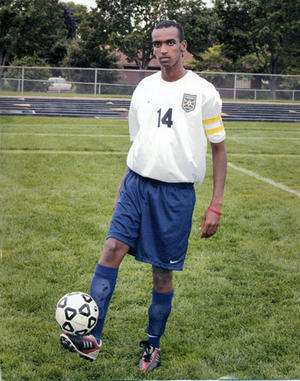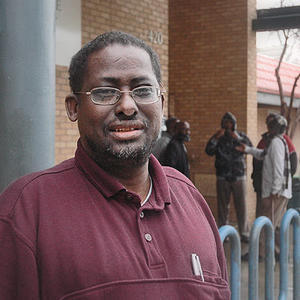Continued from page 1...

By Erin Carlyle
Tuesday, November 11, 2008
 |
| Augsburg College student Ahmednur Ali aspired to become president of Somalia one day, but instead his life was cut short. He was murdered after volunteering at Brian Coyle Community Center. |
If there is a local historian of the Somali struggle, it is Fahia. He's often the one called upon to deliver PowerPoint presentations explaining their history and culture: the food, the clans, religion, traditional dress, those confusing names. "Sometimes someone will employ a lot of Somalis, and we will want their employers to understand," Fahia explains.
Inside Fahia's windowless, closet-sized office at Brian Coyle, an orange batik tapestry embroidered with donkeys, camels, and elephants brightens the dingy white concrete wall behind his desk. From this office, Fahia tracks the piecemeal statistics that trace the outlines of the Somali diaspora. It is difficult, he says, to know the size of the Somali population in the Twin Cities, as no single agency collects the data, but Fahia guesses that the right figure is about 60,000, making it the largest Somali population in North America.
By the late 1990s, thousands of Somalis were coming to Minnesota each year. The refugees were from every conceivable background, a mix of rich and poor, well-educated and illiterate. But regardless of their station in their home country, in Minnesota they all started over. At least one-third were under 18, many of them missing fathers, some both parents, orphans of the war. Some lived with distant relatives; many had experienced the horrors of war and still suffered from post-traumatic stress.
Somalis settled throughout the Twin Cities, many in Eden Prairie, Columbia Heights, Fridley, near Peavey Park and Elliot Park in Minneapolis—but the Cedar-Riverside neighborhood, near the University of Minnesota's West Bank, became the heart of the community. "Cedar," as it is known, is home to Riverside Plaza, six high-rise towers of various heights, containing 1,303 apartments, one of which was once featured as the residence of Mary Richards in The Mary Tyler Moore Show. Now, half of the buildings are low-income housing and they are nicknamed "the Crack Stacks."
The young Somalis struggled hardest to assimilate to their new surroundings. They tried to fit in with the local African American community, but were ostracized for being different. American students pulled the headscarves off Somali girls and mocked students who washed their feet in the bathroom sinks before prayers. "Even being called a Somalian was an insult because of the way they used it," says one former Roosevelt High School student.
To protect themselves, several of the boys banded together into a group called the Rough Tough Somalis. If they saw a Somali getting picked on or beaten up, they'd leap to his aid. They carried broken bottles and the sharpened tips of metal fencing as self-defense weapons.
Within a few years, the violence settled down. School became safe for Somali students, and a new group formed. The Hot Boyz were sharp dressers who sang R&B at a Roosevelt talent show and made all the girls swoon. "They dressed nice, they always asked for more tennis shoes," remembers one young woman who was in high school at the time.
 |
| Saeed Osman Fahia, the unofficial historian of Somalis in Minnesota, understands the social factors that have led to violence among Somali youth |
Other boys wanted to be like them, but as the clique grew, some of the new members of the Hot Boyz started getting into trouble—stealing cars or committing robberies. Before long, the community began to regard them as a gang. The Hot Boyz became a state-documented gang after five of them were involved with the robbing and killing of a Somali woman, a vendor of khat, a mild stimulant that is illegal in the U.S.
This act of violence came a few years after the Bush administration passed the No Child Left Behind act. Stricter laws on foreign language instruction had led to many prominent Somali teachers being laid off. No longer was there a connection between parents and teachers. Kids dropped out and began hanging out together, calling themselves names like Murda Squad, Riverside Riders, Somali Mafia, and Madhibaan With Attitude. These gangs were nothing like the highly organized, regimented street gangs of Los Angeles or Chicago; they were loose-knit groups with shifting alliances and constantly changing names.
"If there's one thing that caused all this, the entire Somali gang problem, it's the No Child Left Behind program," says Shukri Adan, author of the 2007 Report on Somali Youth Issues commissioned by the city of Minneapolis. "In one act, they created a gang culture."
AROUND 7:30 A.M. on December 1, 2007, Minneapolis police officers arrived at a house on Pleasant Avenue in south Minneapolis and found a gruesome tableau. The shoeless, bloodied body of Arie Musse Jama lay stretched across the snow-covered ground in the alley by the house, a bullet hole in his chest and another through his neck. Najib Ali Omar was dead inside the house, also shoeless. They'd been dead for close to three hours by the time the cops arrived.